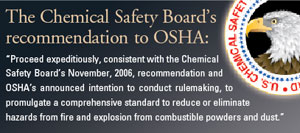'Entirely preventable'
A CSB report urges OSHA and the industry to take steps to prevent combustible dust explosions
By Kyle W. Morrison, associate editorThe Chemical Safety Board recently renewed its call for OSHA to issue a combustible dust standard, following a 19-month examination into what CSB called the worst dust explosion it had ever investigated. The agency on Sept. 24 released its final report (.pdf file) on the Feb. 7, 2008, dust explosion that killed 14 people and injured 38 at the Imperial Sugar refinery in Port Wentworth, GA. The 85-page report details how poor housekeeping (sometimes to the point of knee-deep sugar on the floor), the use of equipment not designed to minimize sugar dust and inadequate evacuation plans led to the explosion. “The explosion of Imperial Sugar was entirely preventable,” CSB Chairman John Bresland said during a press conference detailing the report.
The hazards of combustible dust are well-known in the granulated sugar manufacturing industry and have been so for nearly a century, according to CSB investigator John Vorderbrueggen. The 14 deaths at Imperial Sugar, which occurred in secondary explosions after the initial blast, could have been avoided with effective housekeeping policies and procedures, he said.  A major reason why Imperial Sugar and other facilities may not take the dangers of combustible dust seriously, CSB said, is a lack of catastrophic explosions. Small fires and even small explosions had occurred at Imperial Sugar in the past, but they were quickly extinguished. “We take lessons, and sometimes we take the wrong lesson from what happens and what doesn’t happen,” Vorderbrueggen said. “Unfortunately, it took a tragedy to bring us back to reality.”
A major reason why Imperial Sugar and other facilities may not take the dangers of combustible dust seriously, CSB said, is a lack of catastrophic explosions. Small fires and even small explosions had occurred at Imperial Sugar in the past, but they were quickly extinguished. “We take lessons, and sometimes we take the wrong lesson from what happens and what doesn’t happen,” Vorderbrueggen said. “Unfortunately, it took a tragedy to bring us back to reality.”
CSB’s report made several recommendations to Imperial Sugar for minimizing combustible dust hazards, including following voluntary compliance guidelines from the National Fire Protection Agency. The company said it would take up those recommendations. In 2006, following a CSB study of two decades’ worth of dust explosions, the board recommended OSHA issue a general industry standard on combustible dust – the first time CSB had ever done so. In its September report, CSB reissued that call and advised OSHA to “proceed expeditiously.” Board member Gary L. Visscher said in an interview with Safety+Health that CSB used that language to reiterate its position and to stress the importance of OSHA making the development of a combustible dust standard a priority.
CSB did not recommend OSHA issue an emergency standard for several reasons, including allowing the agency to continue its due process in creating a rule. Bresland noted that OSHA’s success with emergency standards has been limited because most of them have been turned down by the courts. He said during the Sept. 24 press conference that CSB was disappointed in the delay in promulgating a standard, but because the standard’s development was already underway, the board believed it best to allow OSHA to continue its process.
Support for a standard has grown, and Bresland’s own endorsement is evidence of that. In the 2006 report, Bresland voted against recommending OSHA pursue a standard, believing at the time that preventing combustible dust explosions was more a matter of education. He changed his mind after the Imperial Sugar disaster.
“The scale of the devastation of Imperial was very frightening, very sobering,” Bresland said of his experience walking through the plant after the explosion. He said he still believes education is an important aspect of preventing dust explosions, but some facilities will not be able to understand the potential for catastrophe, making a standard necessary.
Earlier this year, Rep. George Miller (D-CA) reintroduced legislation that would force OSHA to issue a standard. More recently, in light of CSB’s Imperial Sugar report, Georgia Republican Sens. Johnny Isakson and Saxby Chambliss have called on OSHA to do the same.
OSHA has taken some steps to address the hazards of combustible dust. In 2007, the agency launched a National Emphasis Program targeting industries in which combustible dust could be present. While the NEP provides guidance to OSHA inspectors to apply the General Duty Clause or other existing standards to conditions related to combustible dust hazards, CSB has found such citations are issued only after a dust explosion has occurred.
OSHA announced this past April that it was developing a combustible dust standard and on Sept. 25 – one day after CSB issued its report – submitted to the White House Office of Management and Budget the standard for review.
Post a comment to this article
Safety+Health welcomes comments that promote respectful dialogue. Please stay on topic. Comments that contain personal attacks, profanity or abusive language – or those aggressively promoting products or services – will be removed. We reserve the right to determine which comments violate our comment policy. (Anonymous comments are welcome; merely skip the “name” field in the comment box. An email address is required but will not be included with your comment.)

